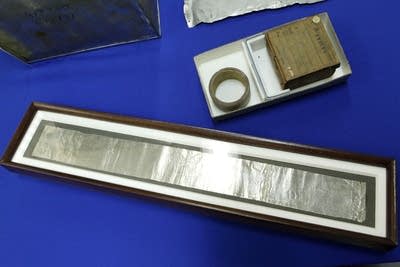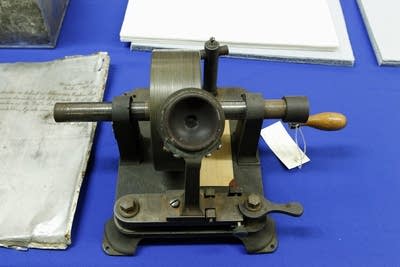Early Alexander Graham Bell recordings played at Smithsonian
Go Deeper.
Create an account or log in to save stories.
Like this?
Thanks for liking this story! We have added it to a list of your favorite stories.

BRETT ZONGKER
Associated Press
WASHINGTON (AP) — Early sound recordings by Alexander Graham Bell that were packed way at the Smithsonian Institution for more than a century were played publicly for the first time Tuesday using new technology that reads the sound with light and a 3D camera.
"To be, or not to be..." a man"s voice can be heard saying in one recording, the speaker reciting a portion of Hamlet"s Soliloquy as a green wax disc crackles to life from computer speakers. Another recording on a copper negative disc that was played back at the Library of Congress reveals a trill of the tongue and someone reciting the numbers 1-2-3-4-5-6.
The recordings date back to the 1880s. Bell had moved from Boston to Washington after inventing the telephone and joined a growing group of scientists who made the nation"s capital a hotbed for innovations.
Turn Up Your Support
MPR News helps you turn down the noise and build shared understanding. Turn up your support for this public resource and keep trusted journalism accessible to all.
During this time, Bell sent the first wireless telephone message on a beam of light from the roof of a downtown building. He and other inventors also were scrambling to record sound on anything they could find. One early sound record looks like a smashed soup can.
Bell partnered with his cousin Chichester Bell and Charles Sumner Tainter at a lab in Washington in the early 1880s. Their group was known as Volta Laboratory Associates.
Inventors were in intense competition. Bell, Emile Berliner and Thomas Edison, who invented the phonograph to record sound on tin foil in 1887, each provided objects and documentation to the Smithsonian to help prove their innovations could record on rubber, glass, brass and other materials. Bell went so far as to seal some of his devices in tin boxes for safe keeping at the Smithsonian.
"This stuff makes the hair stand up on the back of my neck," said Curator Carlene Stephens at the National Museum of American History before the recordings were played. "It"s the past speaking directly to us in a way we haven"t heard before."
On Nov. 17, 1884, Bell"s lab recorded the word "barometer" on a glass disc with a beam of light. This disc and about 200 other experimental records were never played again after being packed away and given to the Smithsonian.
The museum"s collection of about 400 of the earliest audio recordings, including 200 from Bell"s lab, will likely become a key resource for new research on communications and early technology now that they can be played back, Stephens said.
"These materials have been in a cupboard and virtually unknown for decades," she said. "The collection has been silent."
The Library of Congress partnered with the Lawrence Berkeley National Laboratory at the University of California, Berkeley, to offer a first listening session of these early recordings Tuesday. Scientists have spent the past 10 years and about $1 million to develop the technology to create high-resolution digital scans of the sound discs.
This year, scholars from the Library of Congress, the Berkeley Lab and the Smithsonian"s National Museum of American History gathered in a new preservation lab at the Library of Congress to recover sound from those early recordings. A $600,000 three-year grant from the U.S. Institute of Museum and Library Sciences funded the pilot project.
Carl Haber, senior scientist at the Berkeley Lab, said Bell"s recordings and others in the fierce competition of the 1880s marked the start of the information age.
"The whole idea that you could capture the world as it exists" in a recording, he said, "they got that in this period."
Advances in computer technology made it possible to play back the recordings, Haber said, noting that 10 years ago they would have been struggling with computer speeds and storage issues. The digital images that can be processed into sound within minutes would have taken days to process a decade ago.
Many of the recordings are fragile, and until recently it had not been possible to listen to them without damaging the discs or cylinders. So far, the sounds of six discs have been successfully recovered through the process, which creates a high-resolution digital map of the disc or cylinder. The map is processed to remove scratches and skips, and software reproduces the audio content to create a standard digital sound file.
(Copyright 2011 by The Associated Press. All Rights Reserved.)
Dear reader,
Your voice matters. And we want to hear it.
Will you help shape the future of Minnesota Public Radio by taking our short Listener Survey?
It only takes a few minutes, and your input helps us serve you better—whether it’s news, culture, or the conversations that matter most to Minnesotans.






